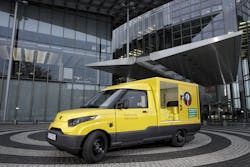Manager: Frank Appel
Title: CEO
Company: Deutsche Post DHL
Operation: Global package and parcel delivery with a ground vehicle fleet of 89,000 units
Problem:
To cut energy costs while establishing a more environmentally sustainable business footprint, Germany’s Deutsche Post DHL began its “GoGreen Program” almost eight years ago. The program targets a carbon dioxide (CO2) emissions reduction of 30% by 2020 against a 2007 baseline level.
“We operate one of the world’s largest vehicle fleets,” notes CEO Frank Appel, pointing out that the global fleet includes 89,000 vehicles, which encompass everything from parcel vans to heavy trucks. “Because we see the effects of global trade on the environment, we accept responsibility.”
Since reducing CO2 emissions directly correlates with reducing energy consumption, DHL engaged in a host of efforts from using more renewable energy sources, to more efficiently managing traffic flows via technology, to modernizing its global ground delivery fleet with alternative drive systems.
Early on, DHL settled on electric vehicles (EVs) largely because those vehicles produce no CO2.
One problem with DHL’s strategy, however, revolved around finding an electric vehicle maker that could build the kind of easy-to-maintain EVs the company desired.
Solution:
DHL says electric vehicles are especially suited for driving in stop-and-go traffic because they emit nearly no air or noise pollution, thus making them extremely environmentally friendly. But finding the right EV maker was proving difficult, so DHL took a different approach.
In 2010, the company helped fund a startup venture called StreetScooter GmbH to construct what the global delivery company dubs “tailor-made” EVs. Then, in December 2014, it purchased the venture outright, including all the development and production rights to electric vehicle models.
Key to the design of the “StreetScooter” is its ability to handle 200 stops and starts per day and be in service up to 300 days a year. The body of the vehicle is a hair over 15 ft. in length, and the vehicle offers a daily range of up to 74.5 mi. with a maximum range of 49.7 mi. in stop-and-go mail delivery service.
To date, some 11,800 units out of DHL’s global fleet of 89,000 vehicles are equipped with a variety of alternative drive systems, fuels and aerodynamic modifications. This includes more than 300 EVs, a third of which are now StreetScooter models.
DHL adds that StreetScooter GmbH, which employs a staff of 70, is a spin-off of RWTH Aachen and a consortium of about 80 industrial companies in the automotive industry and related sectors. Since 2013, StreetScooter has built about 200 EVs annually at the former Talbot/Bombardier plant in Aachen, Germany, which is also where the EV maker’s headquarters is based.
DHL notes that StreetScooter unveiled its first prototype back in 2012, with its first pre-series vehicles going into service with DHL in 2013. About 20 StreetScooter EVs are already working as part of a special “pilot project” to craft “CO2-free” deliveries in the city of Bonn, Germany.
In this project, DHL is converting its entire mail and parcel operations in Bonn to electric mobility by 2016. Nearly 50 more StreetScooters are being used by various DHL sites across Germany, and the company expects 100 StreetScooters to be in operation by the middle of this year.
“The StreetScooter is not only carbon-efficient and quiet, it has also been developed according to the requirements of everyday postal requirements and so perfectly matches our needs,” notes Jürgen Gerdes, corporate board member for mail at Deutsche Post DHL.
“Focusing on city deliveries, we can lower both environmental and noise pollution, and we will be able to reduce our fuel consumption,” he says. “And I am especially pleased that we can make use of our own electric vehicle in the project.”
About the Author
Sean Kilcarr
Editor in Chief
Sean Kilcarr is a former longtime FleetOwner senior editor who wrote for the publication from 2000 to 2018. He served as editor-in-chief from 2017 to 2018.
